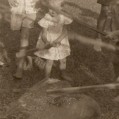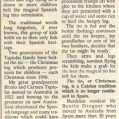
Tió
'Tió tió, caga turró, d´avellana i de pinyó...'
The caga tió takes place during Christmas Eve, after Midnight Mass.
It is covered with a blanket and children beat it with a stick while singing…” tió, tió, caga turró si no cagues fort, et fotaré un cop de bastó!!!”,my attempt to translate it without intending to offend anyone is :“tió, tió, poo some nougat, if you do not poo a lot, I will hit you with a stick!!!” Then, when the blanket is removed… the tió is discovered to have excreted gifts for everyone!!!!
Do you want to know a bit more about the origin of this tradition?
Traditionally, the tió only dropped small gifts such as sweets, chocolate bars, wafers and turrons (atype of nougat traditionally eaten at Christmas). Although over the years the presents have become more sophisticated. The tió does not drop larger objects as those are delivered by the Three Kings from theOrient on the eve of the 6th of January.
Legend has it that in a farmhouse in Sant Quintí de Mediona (in the Penedès region), the youngsters of the village heard a voice coming from the fireplace. “I am coming down! I am coming down!” The youngsters, being the “tough guys”, told him to either come down immediately or to shut up forever! Suddenly, a tió fell down the chimney, followed by another one and yet one more… up to five tions fell down the chimney that day. And they gathered them together to make an old man with a log face who said: “Not far from here there is a hidden treasure, but it is not for you! You must give it to a beggar that will knock at your door tomorrow morning!” The owner of the house could not believe his bad luck… The treasure could have been for him! However, from that day on, the farmhouse enjoyed good fortune forever after.
Although this tradition is of pagan origin, as happens with many other instances, it was adopted by the Catholic religion. It is said that the birth of baby Jesus took a group of peasants by surprise and they had nothing to offer the new born. A very sad young peasant with desperation started beating a log and suddenly, more and more presents started coming out. This is how the peasants got the offerings for baby Jesus.












